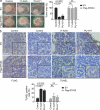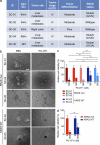Targeting of KRAS mutant tumors by HSP90 inhibitors involves degradation of STK33
- PMID: 22451720
- PMCID: PMC3328372
- DOI: 10.1084/jem.20111910
Targeting of KRAS mutant tumors by HSP90 inhibitors involves degradation of STK33
Abstract
Previous efforts to develop drugs that directly inhibit the activity of mutant KRAS, the most commonly mutated human oncogene, have not been successful. Cancer cells driven by mutant KRAS require expression of the serine/threonine kinase STK33 for their viability and proliferation, identifying STK33 as a context-dependent therapeutic target. However, specific strategies for interfering with the critical functions of STK33 are not yet available. Here, using a mass spectrometry-based screen for STK33 protein interaction partners, we report that the HSP90/CDC37 chaperone complex binds to and stabilizes STK33 in human cancer cells. Pharmacologic inhibition of HSP90, using structurally divergent small molecules currently in clinical development, induced proteasome-mediated degradation of STK33 in human cancer cells of various tissue origin in vitro and in vivo, and triggered apoptosis preferentially in KRAS mutant cells in an STK33-dependent manner. Furthermore, HSP90 inhibitor treatment impaired sphere formation and viability of primary human colon tumor-initiating cells harboring mutant KRAS. These findings provide mechanistic insight into the activity of HSP90 inhibitors in KRAS mutant cancer cells, indicate that the enhanced requirement for STK33 can be exploited to target mutant KRAS-driven tumors, and identify STK33 depletion through HSP90 inhibition as a biomarker-guided therapeutic strategy with immediate translational potential.
Figures









References
-
- Banerji U., O’Donnell A., Scurr M., Pacey S., Stapleton S., Asad Y., Simmons L., Maloney A., Raynaud F., Campbell M., et al. 2005. Phase I pharmacokinetic and pharmacodynamic study of 17-allylamino, 17-demethoxygeldanamycin in patients with advanced malignancies. J. Clin. Oncol. 23:4152–4161 10.1200/JCO.2005.00.612 - DOI - PubMed
Publication types
MeSH terms
Substances
Grants and funding
LinkOut - more resources
Full Text Sources
Research Materials
Miscellaneous

